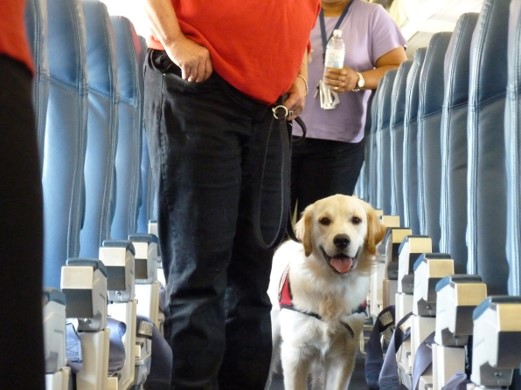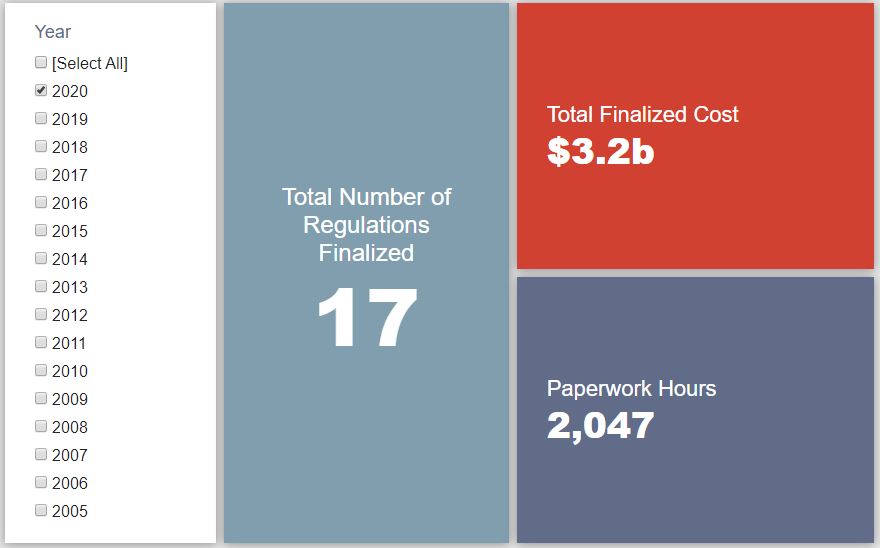Week in Regulation
January 27, 2020
SEC Proposal Blasts Through Otherwise Mundane Week
Most of last week was on track to be relatively balanced in terms of rulemakings hitting the books. A proposed rule from the Securities and Exchange Commission (SEC) changed that, however, bringing in estimated costs in excess of $2.8 billion. In comparison, all other rulemakings netted out to a mere $36 million in new costs. Across all rulemakings, agencies published $2.9 billion in total net costs and added 727,990 hours of annual paperwork.
REGULATORY TOPLINES
- 2020 Proposed Rules: 43
- 2020 Final Rules: 44
- 2020 Total Pages: 4,557
- 2020 Final Rule Costs: $3.2 billion
- 2020 Proposed Rule Costs: $3.7 million
The proposed rule from SEC was the clear leader of the week. The proposal seeks to make a series of changes regarding derivatives trading. The commission estimates that such changes could bring more than $2.8 billion in costs, including $2.4 billion in the first year from “the proposed requirements of the sales practice rule.” Since this is A) a proposed rule and B) from an independent agency, these costs do not apply to the fiscal year (FY) 2020 regulatory budget under Executive Order (EO) 13,771.
TRACKING THE REGULATORY BUDGET
The most notable EO 13,771 action of the week came from a pair of related rules from the Departments of State and Commerce. The rules essentially shift certain reporting requirements for international arms dealers from State to Commerce. This move consequently produces net savings due to there now being a smaller pool of entities required to report such information. The agencies estimate that there will be a net reduction of 5,620 hours of paperwork with roughly $2.7 million in annual savings (or roughly $39 million in present value). For the purposes of EO 13,771 budget procedure, each agency is credited with half of those totals.
Since there were no other actions applicable to EO 13,771, the FY 2020 tally remains stagnant for the week. The Trump Administration expects to reach $51.6 billion in cumulative net savings in FY 2020. To date in the fiscal year, agencies have finalized 44 deregulatory actions and 13 regulatory actions, totaling $2.9 billion in quantified total net costs.
THIS WEEK’S REGULATORY PICTURE
This week, the Department of Transportation (DOT) proposes to crack down on the overuse of emotional support animals (ESAs) on airplanes.

P1020815 by Can Do Canines, licensed under Creative Commons (BY 2.0)
People love their pets. And some people love to take their pets on airplanes. Increasingly, more and more passengers have skirted airline charges for pets to fly by claiming their pets as ESAs. Under current DOT regulations, airlines are not allowed to charge passengers for an ESA to accompany them on a flight. Some passengers have caught on to this loophole. According to airline industry data cited by DOT, airlines carried 56 percent more ESAs in 2017 than they did in 2016, and the trend is likely to continue.
But if a rule proposed by DOT this week is finalized, the days of free transport of ESAs will come to an end.
It is commonly assumed that ESAs qualify as service animals under the Americans with Disabilities Act (ADA). The Department of Justice’s ADA regulations require service animals to be trained for a specific purpose. Most ESAs are not, as their only “skill” is to be present to provide for the emotional support of the owner. DOT’s regulations preventing airlines from charging for ESAs were therefore broader than the scope of the ADA.
As more people began claiming their traveling pets as ESAs, airlines have endured more complications than merely missing out on lost revenue. According to the proposed rule, complaints to both airlines and the Federal Aviation Administration about service animals have increased since 2014. There have also been incidents of animal misbehavior including the biting of passengers, and high-profile instances of more exotic animals being claimed as ESAs, including peacocks and pigs.
DOT’s proposed rule would define a service animal in accordance with DOJ’s ADA regulations and allow airlines to treat ESAs as traditional pets and levy a charge. It would also allow airlines to require passengers with service animals to fill out three new DOT forms, which the agency estimates could impose 140,000 hours (about $3 million in time value) per year on passengers.
TOTAL BURDENS
Since January 1, the federal government has published $6.9 billion in total net costs (with $3.2 billion in finalized costs) and 12.2 million hours of net annual paperwork burden increases (with 2,047 hours coming from final rules). Click here for the latest Reg Rodeo findings.












